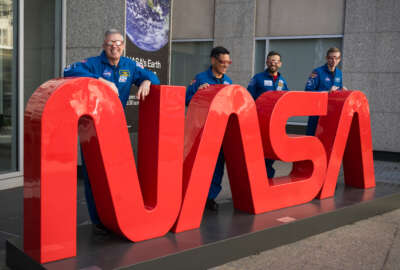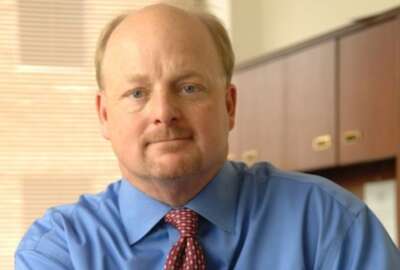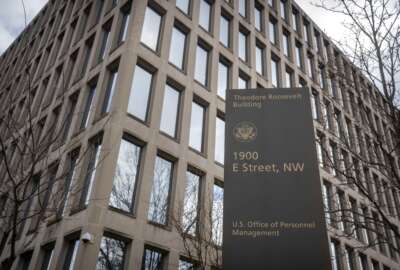Cool Jobs: The Mural Preservationist
Dallan Wordekemper, federal preservation officer with the Postal Service, restores New Deal-era murals at U.S. post offices across the country.


Mouse over the image from left and right to see the mural before and after restoration.
The mural of actor Will Rogers was painted in 1939 and restored in 2004. It hangs in the Claremore, Okla., post office where Rogers had a home and planned to retire. (Images courtesy of USPS)
If viewing on a mobile device, tap image to see before-and-after effect.
By Jolie Lee
@jleewfed
Federal News Radio
| Wordekemper discusses the Will Rogers mural in the Claremore, Okla., post office. (pictured above) |
Post offices may not be synonymous with art, but many, in fact, serve as homes for murals created under New Deal-sponsored art programs.
“People would visit the post office on a regular occasion and have the ability to view the art without having to pay for it,” said Dallan Wordekemper, federal preservation officer with the Postal Service, the federal employee in charge of maintaining the department’s historic art across the entire country.
Between 1934 and 1943, the Postal Service commissioned 1,200 murals and 300 sculptures, the most of any agency in the federal government under the Section of the Fine Arts program, overseen by the Treasury Department.

This program allowed post offices to allocate 1 percent of the cost of constructing the building to go toward commissioning an artist. Muralists typically received about $600, Wordekemper said.
When they received a commission, artists often consulted with the local postmaster and townspeople to create scenes from the town.
“The artist would’ve gone to that particular community and identified some ideas of what were unique to the particular community,” Wordekemper said.
Over the decades, as these murals have deteriorated, the Postal Service has worked with local communities to raise money for restoring the artwork. USPS now contracts with about six companies for restoration work and puts out bids for larger projects, Wordekemper said. 
“We have not really taken the murals out of the communities and moved them to the Smithsonian or to the headquarters office here in Washington, D.C.,” Wordekemper said. “These are unique murals for the communities and they stay in the communities.”
Because USPS murals are located in all 50 states, Wordekemper said he depends on people who go to the post offices — he calls them his “mural email buddies” — to give him updates on the art.
“They tell me whether [the murals] are damaged or at risk,” Wordekemper said. “They give me a great advantage because I don’t have to physically get in the car or airplane and spend money.”
Wordekemper is also responsible for overseeing the disposal of historic buildings to individuals or to states. In his nine years with USPS, Wordekemper said he has worked with almost all 50-plus state historic preservation offices. Once the Postal Service transfers these buildings to the state, its oversight of that property ends, he said.
“So it’s important we identify what the responsibilities are as we transfer them. That is a big part of my job,” said Wordekemper, who previously worked in historic building preservation.
The murals, however, will remain in federal control — despite last year’s announcement that the financially-struggling Postal Service had identified 3,700 post offices for closure. This “caused some concern” about what would happen to the historical artwork in these post offices, Wordekemper said.
USPS has developed an art loan program so if a post office closes or changes buildings, the artwork can be moved somewhere else within the community.
“The highest and best use is to stay in its original location if possible,” Wordekemper said.
Federal News Radio’s Andrew Mazzocchi and Michael O’Connell contributed to the design.
RELATED STORIES
More from Cool Jobs in Government:
Copyright © 2025 Federal News Network. All rights reserved. This website is not intended for users located within the European Economic Area.





